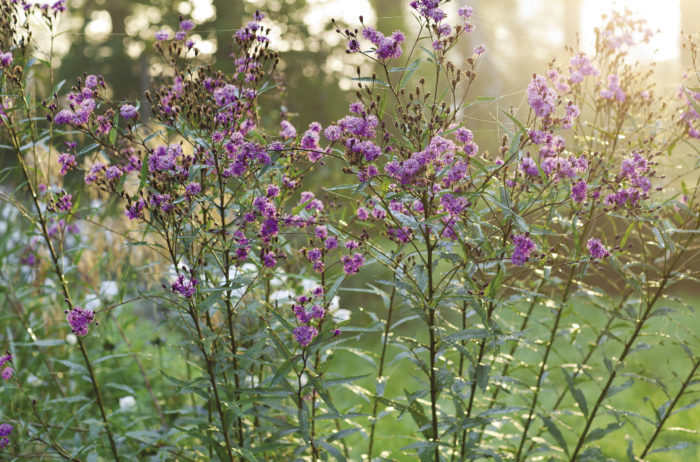

Vernonia spp. and cvs.
USDA Hardiness Zones: 4 to 9
Conditions: Full sun to partial shade; moist, well-drained soil but adaptable to drier and/or gravelly soil
Bloom Time: Mid- to late summer through mid- to late fall
Troubles: Powdery mildew and rust
Someone recently said to me that ironweeds are ecological plants, not garden plants. This proclamation got me thinking differently about these imposing natives. Is this a common perception among gardeners? Does my affinity for ironweeds blind me to their shortcomings (no pun intended)? I remember the first time I saw an ironweed in a garden: It seemed impossibly tall, but the high crown of purple flowers aflutter with butterflies and bees mesmerized me, and it was love at first sight. But since that first glimpse, I’ve rarely encountered ironweeds in cultivated landscapes. At 7 to 12 feet tall, their daunting size likely unnerves some gardeners and certainly excludes them from small gardens.
Given this, the question of their garden-worthiness lies at the root of my long-running trial. While there are a few distant cousins in the group, many ironweeds are native to North America. Nowadays, the growing interest in pollinators has made native plants sexy, so it’s the perfect time to get to know ironweeds a little better. Ignoring their size would be like avoiding the elephant in the room, but I challenge gardeners to consider all their other fantastic attributes and give ironweeds a closer look.
Top Performers are Worth the Investment
Trial Parameters
Since 2010, the Chicago Botanic Garden has evaluated 17 different ironweeds.
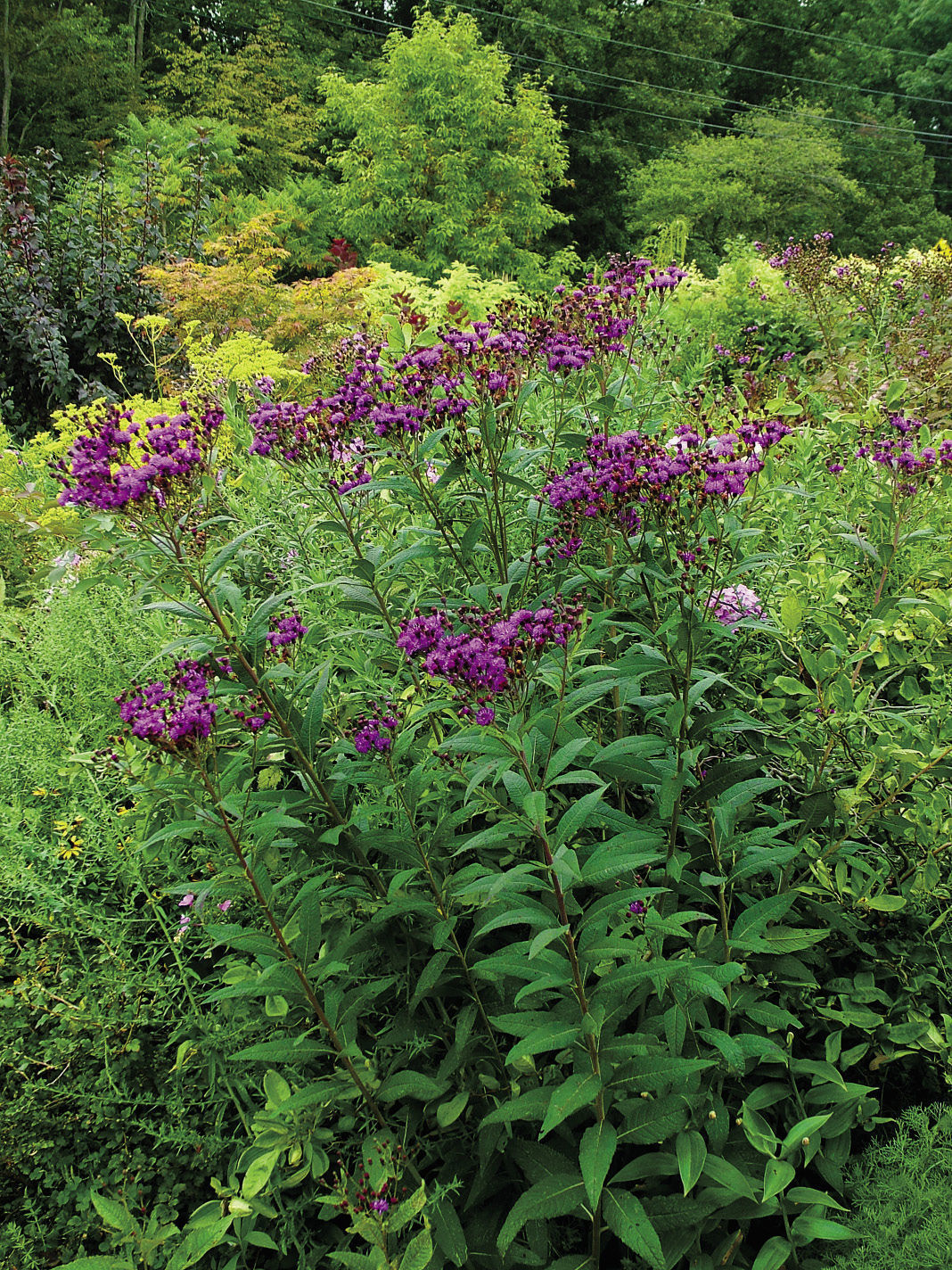
Giant ironweed (V. gigantea) was the second tallest in the trial, reaching a towering 103 inches. For such a large plant, I expected a much bigger flower, but, at half an inch wide, the purple-violet flower heads are among the smallest. Thanks to huge flower clusters—well over a foot across—giant ironweed always puts on a magnificent show, though. The 9-inch-long, grayish green leaves are impressive in size, and a hint of purple in the topmost ones and stems is a nice treat. In a large space, silvery gray–leaved ‘Skywalker’ Indian grass (Sorghastrum nutans ‘Skywalker’, Zones 4 to 9) is a beautiful companion to giant ironweed.
Duration: A minimum of four years.
Participants: Ten ironweed species plus seven cultivars and hybrid selections. Eight of the species were wild-collected; we observed variable traits among plants within these species.
Zone: 5b
Conditions: Full sun; well-drained, alkaline, clay-loam soil.
Care: Minimal, allowing the plants to thrive or fail under natural conditions.
Nowadays, the growing interest in pollinators has made native plants sexy, so it’s the perfect time to get to know ironweeds a little better.
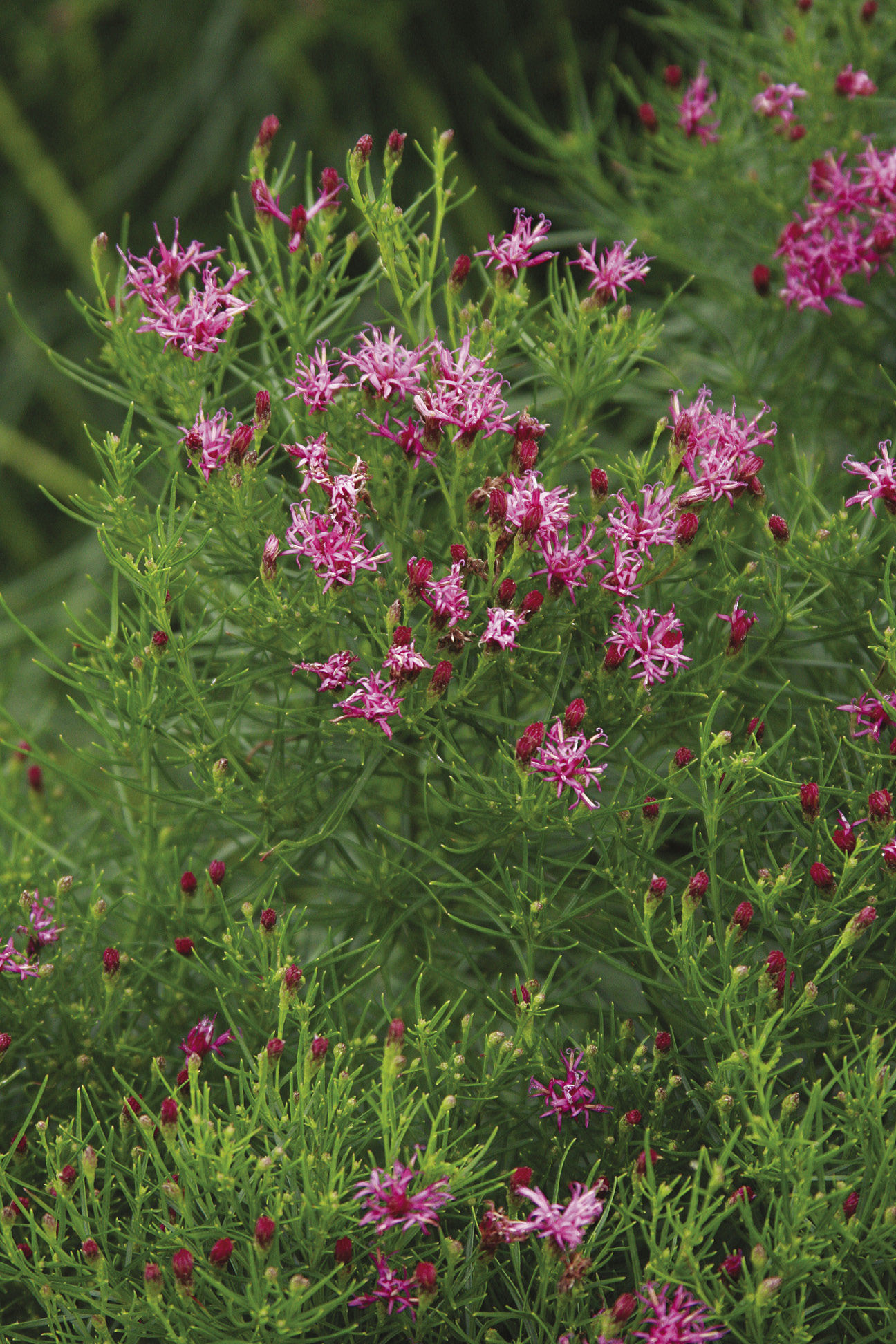
No other ironweed has the look or texture of narrowleaf ironweed (V. lettermannii). Soft, needle-shaped leaves cover the stems from top to bottom, giving the plant a shaggy appearance, which can be confused with another Arkansas native, spring-blooming threadleaf bluestar (Amsonia hubrichtii, Zones 5 to 8). Come late summer, there is no question of its affinity when the stem tips branch into large clusters of small purple flowers. The habit of ‘Iron Butterfly’ narrowleaf ironweed (V. lettermannii ‘Iron Butterfly’) is shorter and less prone to opening up in the center than the species. In full sun, ‘Iron Butterfly’ is so compact, it looks sheared; in partial shade, the tightness is not as pronounced. ‘Iron Butterfly’ is showing up in catalogs and garden centers more and more, attesting to its great qualities and gardeners’ desire for something different. And, let’s be real, its name is ingenious!
In an objective trial, there should be no favorites, but Missouri ironweed was mine.
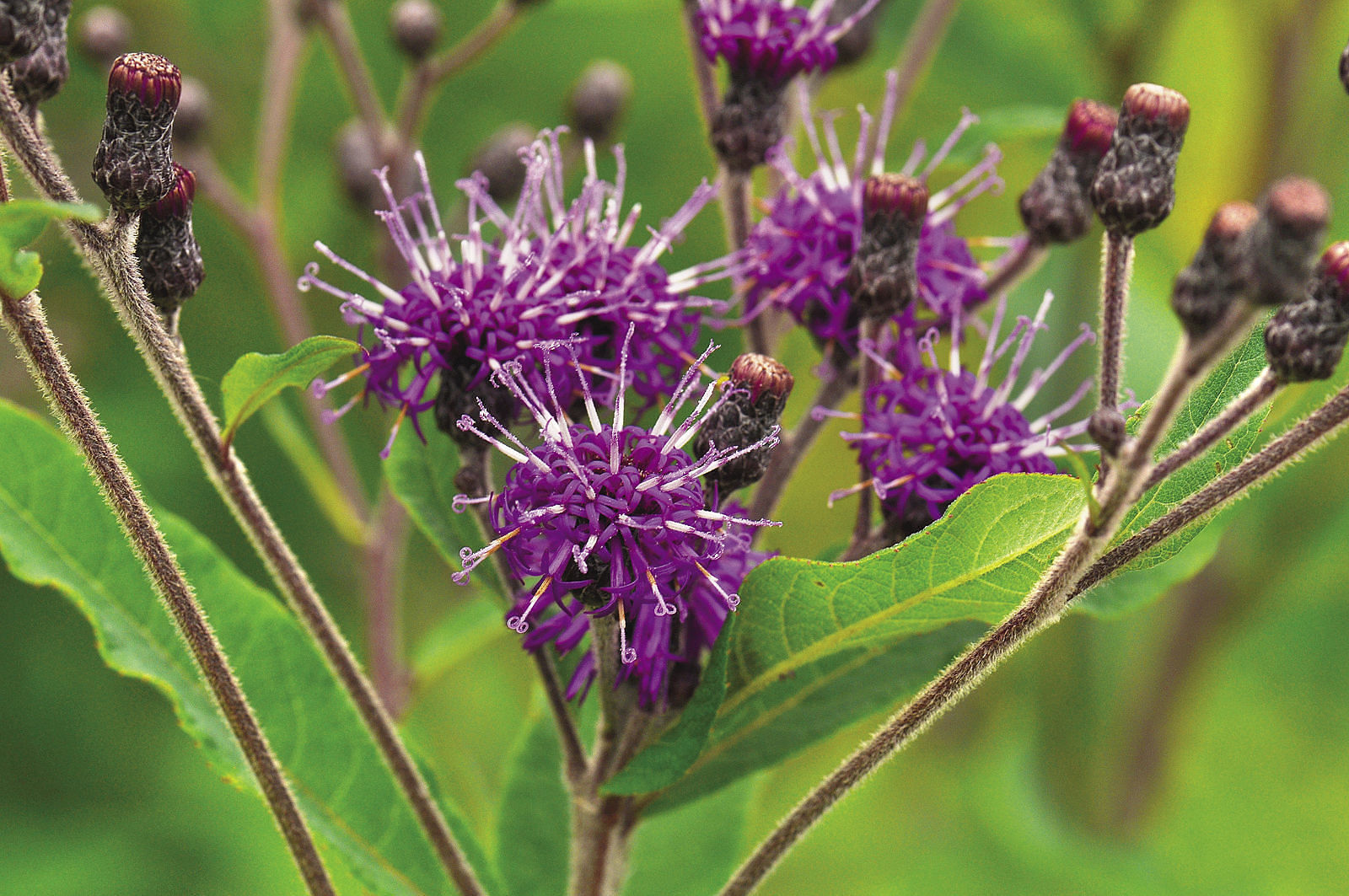
In an objective trial, there should be no favorites, but Missouri ironweed (V. missurica) was mine. Bright violet flowers sprout from plump purple buds, putting on one of the best shows of late summer I’ve seen. Its lance-shaped leaves, up to 7 inches long, are fuzzy and silvery due to the dense white hairs on the undersides. As a toucher, I never pass Missouri ironweed without caressing the velvety leaves. Compared to other ironweeds, I’ve always thought there is something more refined about Missouri ironweed than its stoutness suggests.
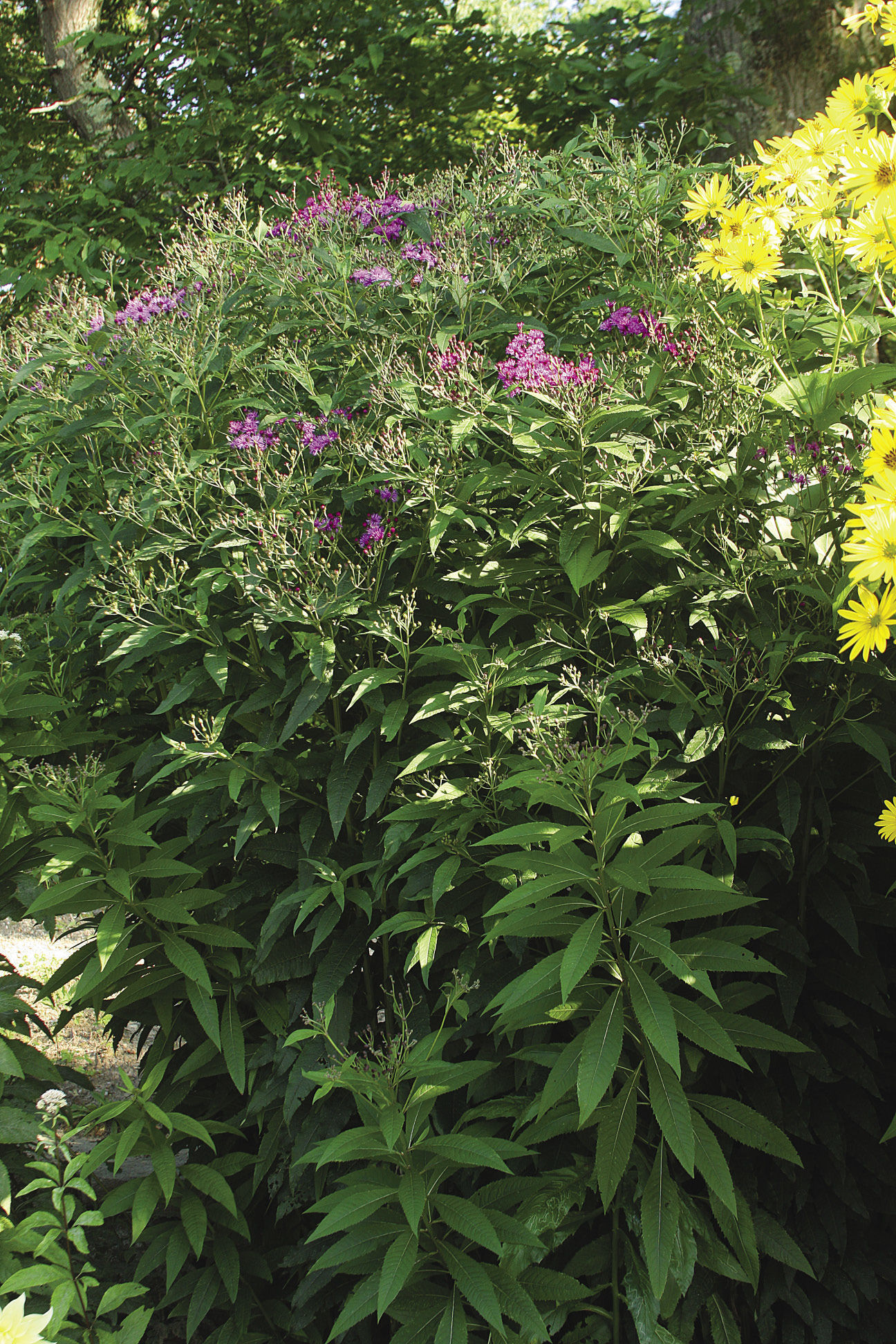
New York ironweed (V. noveboracensis) was my introduction to the genus, so I have a soft spot for it. Of all the ironweeds in the trial, it was the gangliest in its youth, although over time it develops a strong bushy habit. In autumn, cavorting monarch butterflies are especially brilliant against the deep purple flowers. Its dark green, lance-shaped leaves are big—up to 8 inches long, a little coarse, and borne on stiff, purplish stems. New York ironweed had the distinction of remaining rust free during our trial—an attribute shared only with narrowleaf ironweed. Although New York ironweed grows naturally in wet sites, it is adaptable to drier conditions, too.
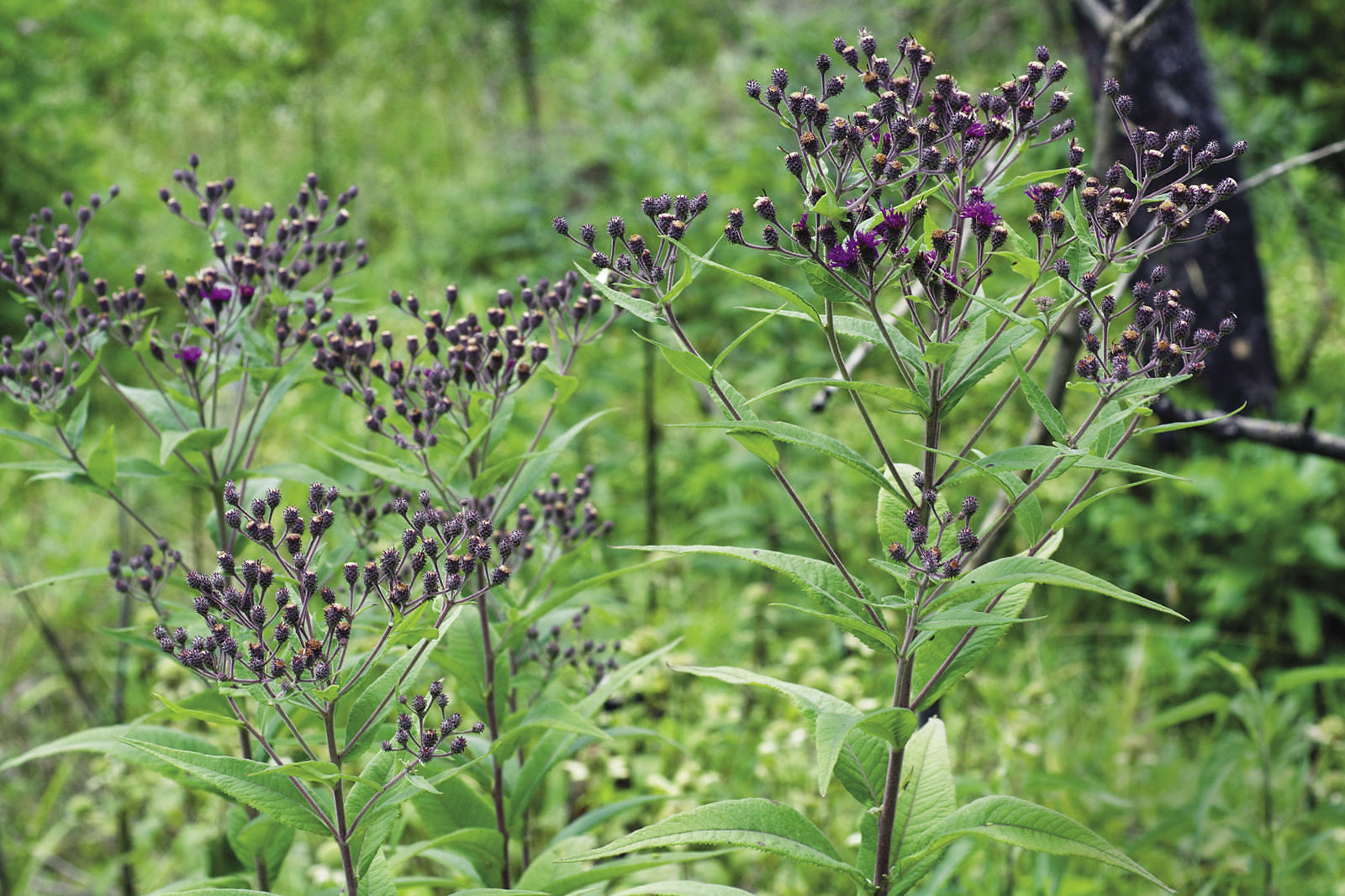
From a distance, western ironweed (V. baldwinii) looks a little like Joe-Pye weed (Eutrochium spp. and cvs, Zones 4 to 9), but its attractive, lance-shaped leaves—rough on the surface and softly hairy on the underside—are not whorled like its cousin’s. The same white hairs clothe the arrow-straight stems, which branch in midsummer to hold purple flowers in loose, flattened clusters. The scales of the floral bracts recurve at the tips, giving the rosette a barbed appearance, but it’s not at all prickly. Given the smaller flower heads—less than an inch wide—the floral display is not as vivid as Arkansas ironweed, but it’s as bountiful as any ironweed. The upright habit is handsome and narrow—well, at 50 inches wide, what passes for narrow for an ironweed. Contrary to warnings, western ironweed did not spread or create a colony during seven years in the trial.
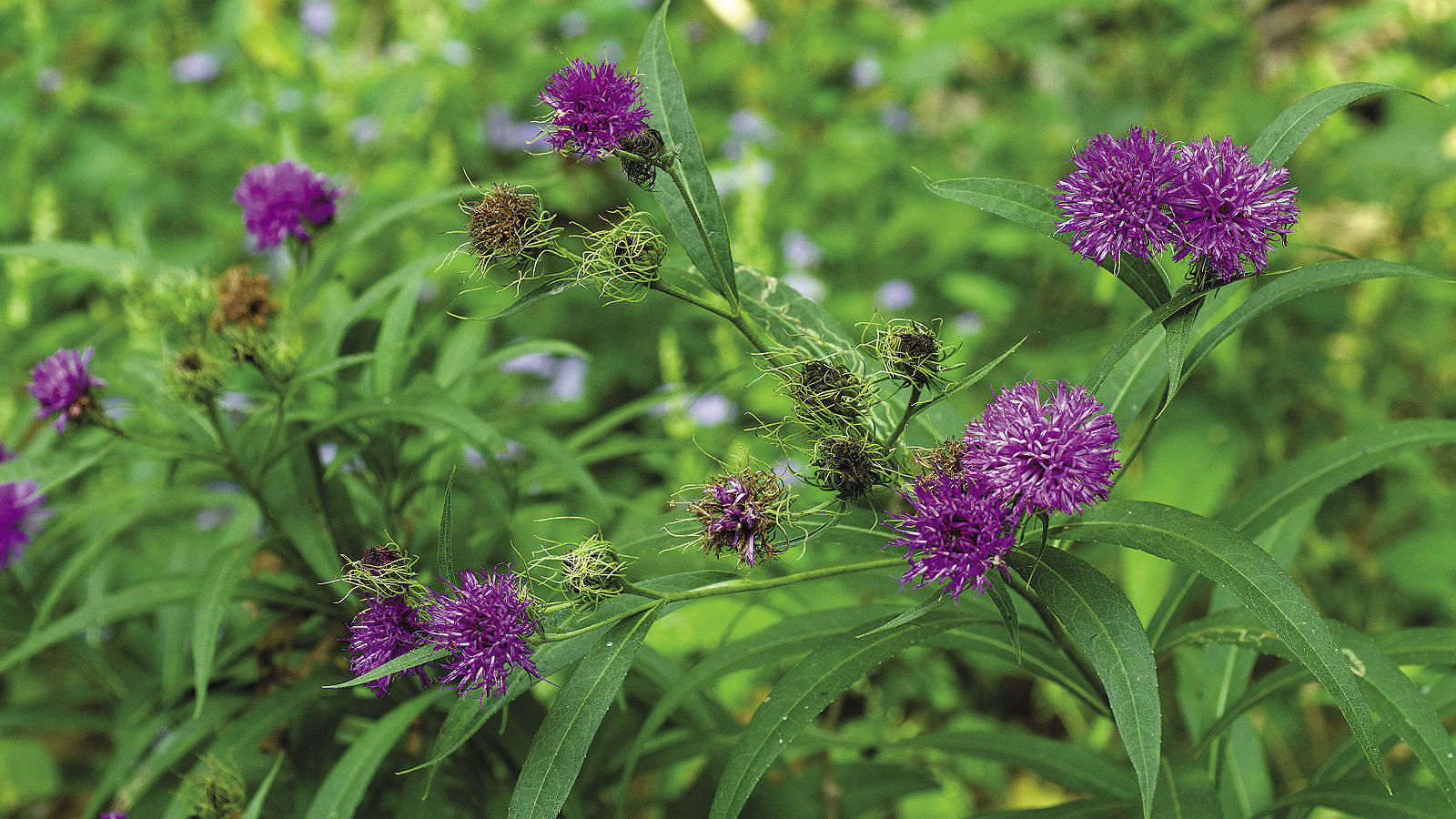
Arkansas ironweed (V. arkansana) is readily recognizable by the long, thread like appendages on its floral bracts, which is undoubtedly the origin of its alternative common name: curly top ironweed. Purple flowers in large heads to 1¼ inches wide look like pincushions atop the tall, stiff stems in late summer. Like other species in the trial, these plants came from seed that was wild-collected in the Ozarks; being seed-grown, foliar and habit traits varied slightly among the plants. The narrow, willow-like leaves—up to 7 inches long—were occasionally dusted with late-season powdery mildew and rust. Hummingbirds have always been rare sightings in the trial gardens, but they joined in with the butterflies and bees on this ironweed.
New Kids to Keep an Eye On
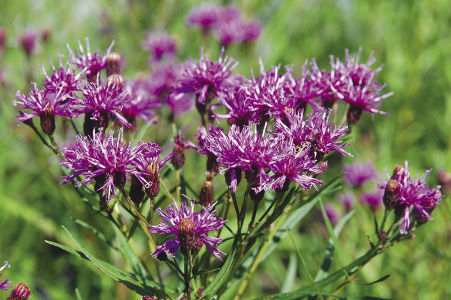
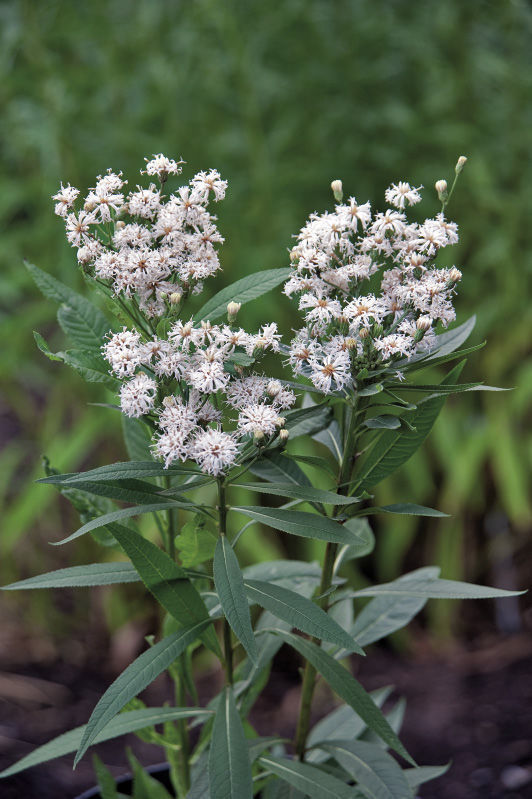
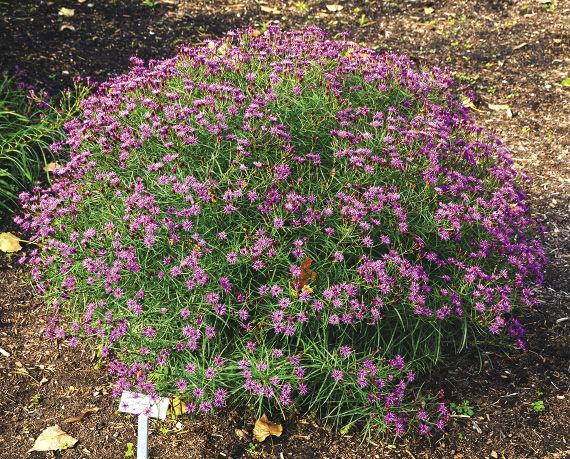
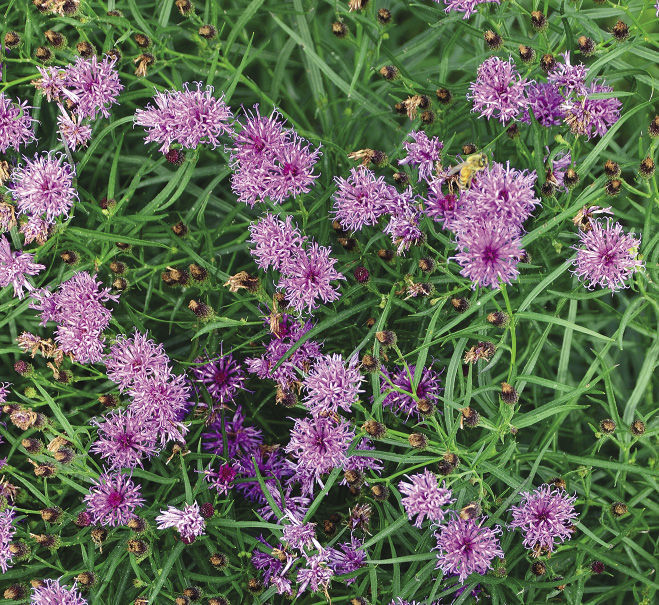
Basics
Ironweed 101
Ironweeds are long-lived perennials that rarely need division. The common name may be a nod to the iron-like rigidity of the stems or more likely refers to the rusty hairs on the cinnamon-colored seeds. Here’s what else you need to know:
Habit: Plants tend to grow taller in moist soils, although some are drought tolerant once established.
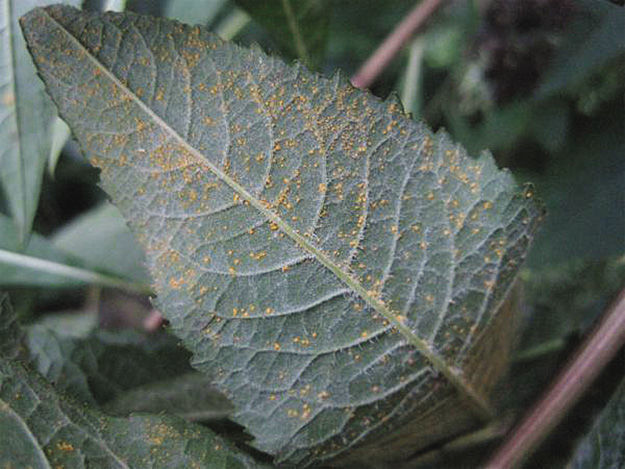
Pests and Disease: Powdery mildew and rust can infect foliage in fall. Their bitter-tasting leaves are not palatable to most mammals, including deer, but rabbits occasionally browse narrow-leaf ironweed and ‘Plum Peachy’ tall ironweed.
Pruning: To reduce plant size, cut back new stems by half in late spring; in our trials, plants were up to 18 inches shorter when sheared.
Flowers: Ironweeds are in the aster family but lack their flamboyant, petal-like ray florets. Instead, upward of 50 or more tubular disk florets crowd into compact flowerheads enclosed by leafy bracts that are unique to a species and helpful in identification. Some flowerheads measure a foot across or more.

Pollinators: It’s nearly impossible for me to picture the flowers without a mélange of bees and butterflies hovering overhead, as they are so much a part of the floral show.
Foliage: The dark green foliage tends to be lance shaped but can be willow-like or feathery. Leaf size enhances the bigness of some ironweeds; for example, giant ironweed tops out at 8 feet tall, but the 10-inch leaves make it seem even larger.
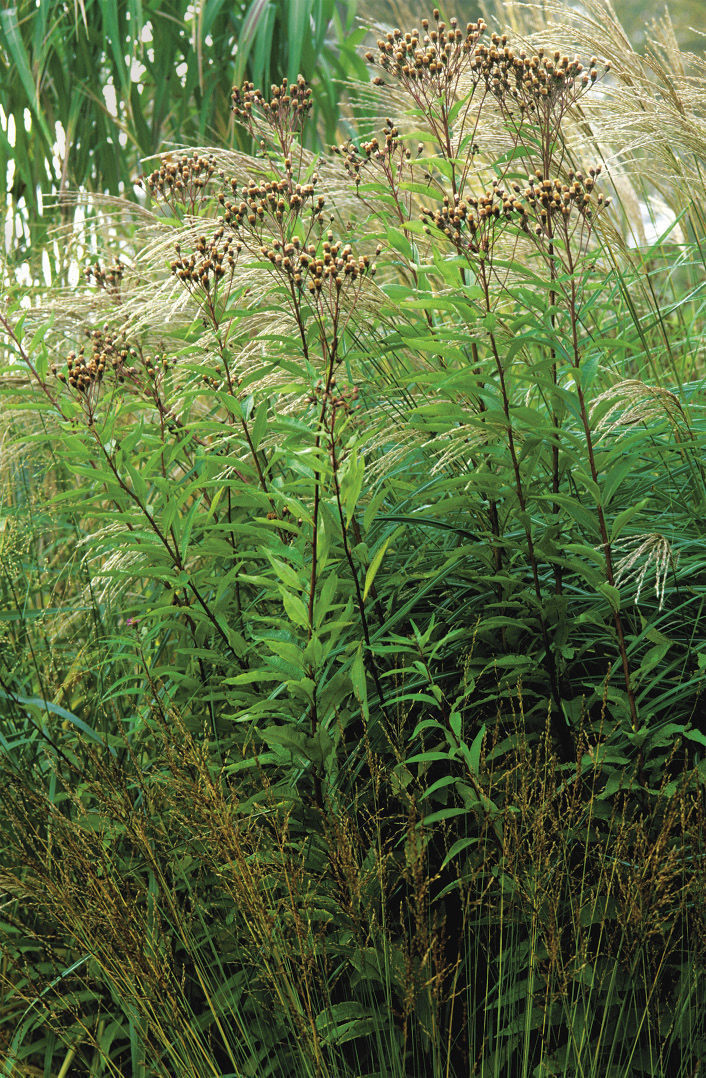
Seed Heads: Deadheading reduces unwanted seedlings; however, if left in place the seedheads add extra interest in late fall and in winter.
Ironweed Trial Result
| Overall Rating | Vernonia | Height | Width | Flower Color | Flower Size |
| ★ | V. angustifolia ‘Plum Peachy’ | 42 inches | 28 inches | violet-purple | 1 inch |
| ★★★ | V. arkansana | 70 inches | 60 inches | purple | 1¼ inches |
| ★★★ | V. baldwinii | 68 inches | 50 inches | purple | ¾ inch |
| ★★★ | V. chinensis | 82 inches | 50 inches | light purple | ¾ inch |
| ★★ | V. fasciculata | 67 inches | 72 inches | purple | ¾ inch |
| ★★★★ | V. gigantea | 103 inches | 65 inches | purple-violet | ½ inch |
| ★★★ | V. gigantea ssp. gigantea | 100 inches | 82 inches | purple | ¾ inch |
| ★★★ | V. gigantea ssp. gigantea ‘Jonesboro Giant’ | 144 inches | 60 inches | purple | ¾ inch |
| ★★★ | V. glauca | 72 inches | 64 inches | purple-violet | 1 inch |
| ★★★ | V. lettermannii | 43 inches | 48 inches | purple | ½ inch |
| ★★★★ | V. lettermannii ‘Iron Butterfly’ | 33 inches | 54 inches | purple | ½ inch |
| ★★★ | V. missurica | 74 inches | 64 inches | bright purple | 1 inch |
| ★★★ | V. noveboracensis | 80 inches | 74 inches | deep purple | 1 inch |
Rating key
★★★★ Excellent
★★★ Good
★★ Fair
★ Poor
*Plant height includes flowers.
Richard Hawke is plant evaluation manager at the Chicago Botanic Garden.
Photos: Marianne Majerus/Marianne Majerus Garden Images, Nancy J. Ondra, Michelle GervaisPhotos: millettephotomedia.com, Courtesy of N.C. State Extension, Courtesy of Chicagoland Grows, Jo Whitworth@gapphotos.com, Intrinsic Perennial Gardens, Courtesy of Jelitto Staudensamen GmbH, Courtesy of Chicagoland Gardens
Sources:
Laporte Avenue Nursery, Fort Collins, CO; 970-472-0017; laporteavenuenursery.com
Pine Ridge Gardens, London, AR; 479-293-4359; pineridgegardens.com
Prairie Moon Nursery; Winona, MN;866-417-8156; prairiemoon.com
Prairie Nursery, Westfield, WI; 800-476-9453; prairienursery.com
Fine Gardening Recommended Products

Wagner's 52003 Classic Blend Wild Bird Food, 6-Pound Bag
Fine Gardening receives a commission for items purchased through links on this site, including Amazon Associates and other affiliate advertising programs.
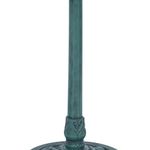
Alpine Corporation 28" Tall Outdoor Birdbath with Scrollwork Decoration Yard Statue
Fine Gardening receives a commission for items purchased through links on this site, including Amazon Associates and other affiliate advertising programs.

Gardena 3103 Combisystem 12-Inch To 20-Inch Adjustable Metal Fan Rake Head
Fine Gardening receives a commission for items purchased through links on this site, including Amazon Associates and other affiliate advertising programs.


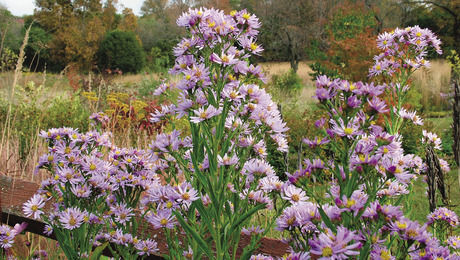
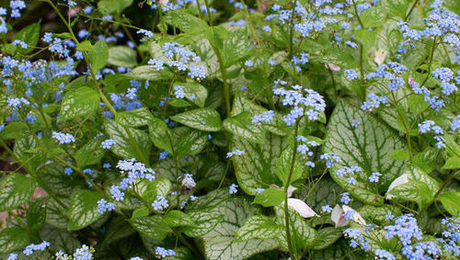














Comments
Log in or create an account to post a comment.
Sign up Log in